| 1 | Striped road guarder |
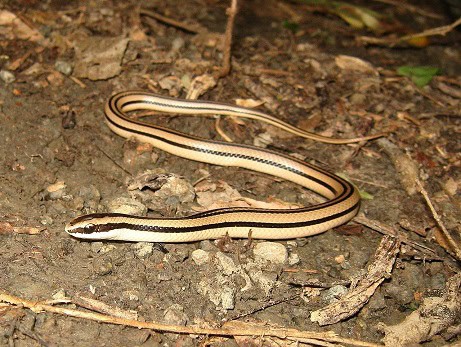
A Mexican snake which is extremely recognisable, with a grey-beige base overlaid with black lines running lengthways down its body. Striped road guarders (Conophis vittatus) are common in human areas, in towns, and even grassland near airports. Naturally, its habitats are tropical deciduous forests and dry scrubland, and while it lacks venom, it’s extremely common due to its speed and agility.
They also have several bonus tricks up their sleeves, one being death-faking. Scientists were in an area of deciduous and oak forest in Jalisco, Mexico. They disturbed a striped road guarder, and initially, it reacted normally, becoming agitated, making rapid movements, producing a foul smell, attempting to bite. Generally acting unhinged, in other words.
The scientists wrestled it into a bag, and then its demeanor changed: the striped road guarder rotated its upper body, gaped its mouth wide, and went completely limp. It ceased to react to any external stimulation. If you saw a picture you’d instantly think it was devoid of life.
After 1 minute, the road guarder rotated its entire body onto its back and stayed immobile. It took 11 minutes until the snake reactivated and attempted to escape. This striped road guarder was found under a log in a forest, rather than slithering around openly like they commonly do, so maybe it was already in a defensive mode. This snake has different survival strategies for different situations.
Striped road guarders prey on reptiles, such as the Colima giant whiptail. Their heartland is southern Mexico, but they also reach far western Guatemala.
| 2 | Grey-banded kingsnake |
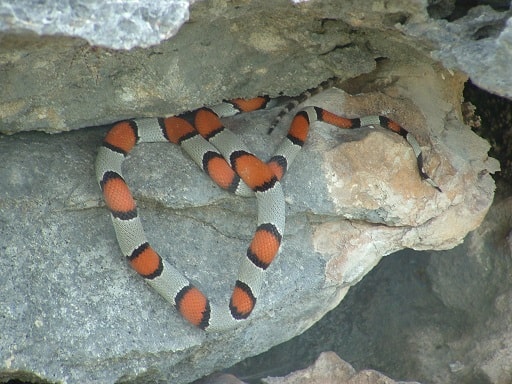
It’s one thing for scientists to admire a snake’s death-faking skills in a lab, but some are so skilled that they can actually fool professional snake investigators. The grey-banded kingsnake (Lapropeltis alternata) is one of those.
In 1973, scientists were driving down a highway in Presidio County, Texas, when they spotted a ringtail cat, standing over a grey-banded kingsnake. They assumed that the kingsnake was roadkill and the cat was scavenging its corpse. The snake was fully limp, and remained limp while the scientists examined it. When placed on the ground, the kingsnake didn’t right itself.
It was clearly dead, so the scientists placed it harmlessly on the passenger seat of the car, in a semi-coiled position, and drove off. The problem was that 10 minutes later, the snake was no longer there. It had disappeared, and they found the kingsnake crawling through the springs beneath the car seat, very much alive.
They also reported death faking among baby (neonate) grey-banded kingsnakes. When disturbed, one neonate became limp with a crooked neck, and its mouth slightly open. The scientists backed off, and the kingsnake righted itself, and crawled off. When they returned, it instantly re-entered the death-faking charade. Faking death isn’t especially common in Lampropeltis kingsnakes of the USA, but this species is an exception.
| 3 | DeKay’s brown snake |
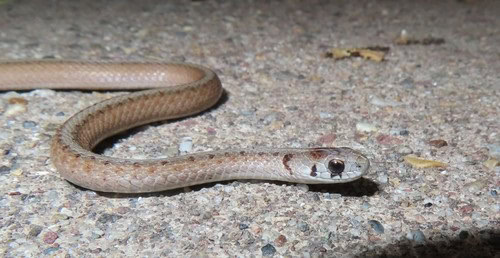
Storeria dekayi, or Dekay’s brown snake, is the most common snake in US cities overall, with an immense ability to survive in suburban housing estates or even concrete jungles if there’s some form of grass. Dekay’s brown snakes prey on slugs and earthworms, which means that there’s food everywhere. It’s not their venom which has allowed them to achieve domination, as they don’t have any; the best they can do is chew your finger mournfully.
However, Dekay’s brown snake does have a huge amount of death-faking talent. According to this technical review of death-faking (thanatosis), Dekay’s brown snake has exhibited 6 death-faking behaviors across various studies. These include…
Tonic immobility – becoming temporarily rigid, like a corpse.
Supination – flipping over onto its back.
Mouth gape – deliberately hanging its mouth open wide, like all life is gone.
Contortions – twisting and thrashing as though in death throes.
Stiffness – mimicking the rigidity of a corpse.
Tongue protrusion – a classic piece of death-faking acting skill.
All these behaviours are released when the aggressor turns away. There’s good chance that a Dekay’s brown snake is lurking in your backgarden, if you live in the eastern half of the USA. Be on your guard next time you’re shifting garden furniture and plant pots around.
| 4 | Graceful adorned snake |
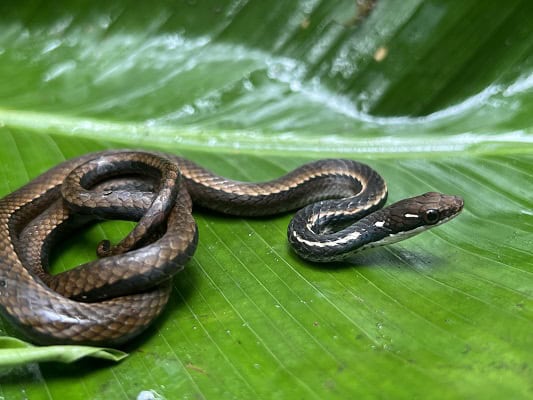
A mild-mannered snake with an intense death-faking performance. This species measures 35-60cm and ranges from southern Mexico to western Colombia.
Scientists were exploring a sea turtle conservancy in Costa Rica when they found a graceful adorned snake (Rhadinaea decorata) crossing a walkway. It was right in the open, 25 metres from the nearest cover object. The scientists approached. Immediately, the snake started convulsing violently, with “seizure-like contractions down the length of its body”. It released a foul musky smell, and flipped over onto its back, falling to the ground, and remained limp for several minutes.
The scientists even prodded the snake and failed to break its death-feigning performance. The scientists then placed the graceful adorned snake on leaf litter. After a few moments, it reactivated, and went on its way, pleased with its work, probably believing that the scientists were 100% fooled.
This species is recognisable by its browner body contrasting against a pale ocular stripe: a white line running unbroken though its eye, on both sides of the head. Its diet mainly includes amphibians, including poisonous ones like strawberry poison-dart frogs.
| 5 | Dryophylax nattereri |

A nocturnal snake, which you’re only likely to spot against a background of true darkness. Amazon coastal houses snakes were once part of the Thamnodynastes group, before being moved to the Dryophylax genus in 2022. This species is particularly common in southeast Brazil, including the outskirts of Sao Paulo, and in Atlantic forest areas, where they love to lurk on the edges of forest streams and marshes and wait for their frog prey.
Dryophylax nattereri has a huge repertoire of defensive skills, except actual venom. They’re capable of thrashing their body wildly, flattening their neck to appear larger, and triangulating their head to mimic a viper. If these intimidation skills fail, they can release a vile smell. If these disgust skills fail, they can pretend to be dead so that any potential predator gives up, lacking the taste for a corpse.
In 2016, scientists were prowling Atlantic forest, when in a marshy area, one picked up a Dryophylax nattereri. Firstly, it hid its head for 1 minute. Then a detailed death-faking spectacle was activated; the snake contorted its body, and protruded its tongue limply from its mouth.
When placed on the ground, it continued contorting itself and became immobile like a corpse. When the camera was 10cm from the snake, it flipped over onto its back. The death-faking charade lasted for 5 minutes in total.
| 6 | Great plains ground snake |
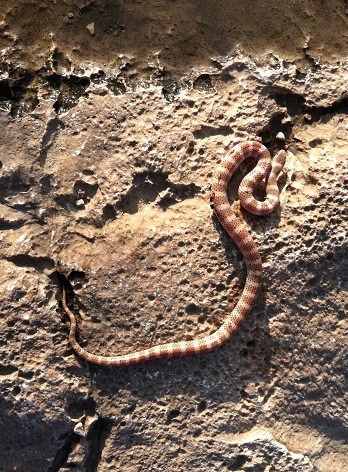
The Great Plains ground snake (Sonora episcopa) lives in the southern USA, especially Texas, as well as northern Mexico. They measure 20-45cm and are found in semi-deserts, dry rocky slopes and old dried out streambeds. One of their favourite survival strategies is living hundreds of miles away in a dusty desert where no-one will ever bother them. But they still have to contend with swooping birds and hungry coyotes, and to combat them they often fake death.
In the heat of the desert, Sonora episcopa will go limp to mimic a corpse, cock its neck like all life is gone, and go unnaturally stiff. This death-faking performance most likely succeeds with some birds or other predators, otherwise it would not have survived.
Great Plains ground snakes vary significantly in appearance, but are commonly orange with fine black bands, blending perfectly with dry soil. This snake preys on scorpions, centipedes and spiders, and they’re intelligent enough to vary their hunting style. With spiders, they lunge in with little tactics, but with scorpions they carefully restrain them and inject a mild venom (too weak for humans).
| 7 | Hemprich’s coral snake |
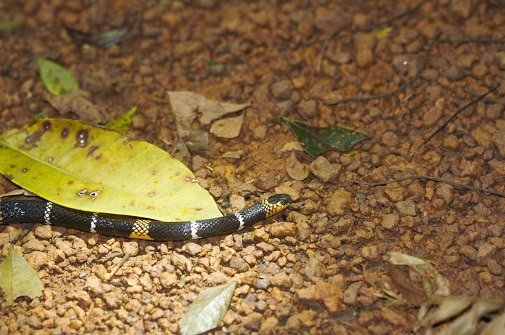
Hemprich’s coral snake is one of the more memorable species among a family that tends to blend in with each other. Firstly, they lack any red, preferring shades of black, yellow and white. Secondly, they’re known to practise male wrestling, where two competing males will coil around each other and slam each other to the ground. This combines with a venom that can cause uncomfortable shortness of breath, and in 2014, the following skill was discovered: death faking.
The scene was a forest path in Rondônia, northern Brazil, where scientists spotted a coral snake slithering into leaf litter along the edge. It was a Hemprich’s coral snake, and as soon as it was manipulated, it became lethargic. As scientists handled it with a snake hook, the coral snake gaped its mouth wide and flipped onto its back.
Most importantly, the coral snake ceased all response to external stimuli. The answer to this riddle was sudden death, and the coral snake kept up the act for 4 minutes. Only when the scientists moved to 5 metres away did the coral snake reactivate, thinking the coast was clear.
This species exists in virtually the entire Amazon region, and therefore overlaps with many other coral snakes. The lack of red is a good ID sign. The report found 3 death-faking beaviours: gaping its mouth, immobility, and flipping over. This is the most known for an indivudual species in the coral snake family so far. Two other species have two behaviours recorded: the eastern coral snake of Florida, and southern coral snake (Micrurus frontalis) of Brazil.
| 8 | Forest flame snake |
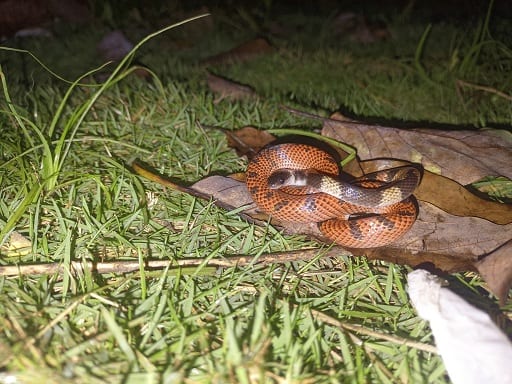
Forest flame snakes (Oxyrhopus petolarius) cover a huge swathe of South America, and are probably the king of snakes when it comes to rapidly fleeing into the bushes. Forest flame snakes are harmless to humans, and if you stray too close, they’ll use their rapid speed to dash into the undergrowth within seconds and never come back. You may never lay eyes on them again, or see them the next day, only to get one inch closer than last time before they vanish all over again.
This rapid flight has enabled them to take over approximately 50% of South America. Forest flame snakes have one secret weapon though, which they don’t use too often. They’re able to fake death, as spotted in 2021 in Panama’s Veraguas Province.
Researchers placed a forest flame snake in a clearing, attempting to take photos. Initially, it attempted to flee as usual, but when it was recaptured and placed on the spot, it flipped over its body, attempting to play dead. It remained motionless for an entire minute, before it flipped back over and attempted to flee again.
Initially, the Oxyrhopus petolarius deployed its usual fleeing strategy, so playing dead is clearly a handy back up. Forest flame snakes are commonly found in cloud forests, rainforests, dry forests, and even savannah-like habitats – anywhere with vegetation to flee into. They’re excellent at climbing, though tend to stick to lower branches and bushes below 3.5 metres, and are equally comfortable on the ground.
| 9 | Spot-bellied slug-eating snake |
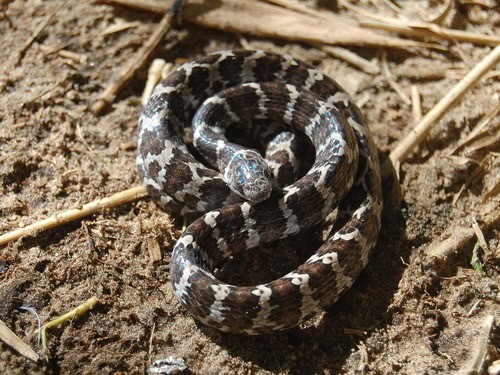
From the deserts of Texas, we now transfer to the grasslands of Paraguay, for another death-faking snake: the spot-bellied slug-eating snake (Dipsas ventrimaculata). This species has viper-mimicking patterns of alternating grey and white, but lacks any venom. It feeds on small slimy creatures, measures 30-40cm, and cannot hurt a human being.
Scientists came across a Dipsas ventrimaculatus inside a house in southern Paraguay. It was covered with cobwebs and fluff, and tried to free itself using sudden, sharp movements of its head. Eventually, it fully hid its head in the centre of its coils to shield itself. The scientists generously intervened, and prised the snake apart in order to remove the remaining cobwebs from its body.
At this point the slug-eating snake became completely limp and motionless. Scientists removed the last few cobwebs and placed it on the ground. The snake remaining limp and motionless. It seemed like it had died from the stress, but several minutes later, the snake reactivated and was full of life.
Scientists seized the snake again, and this time, it flipped its body over the reveal the belly, and became completely stiff. The slug-eating snake remained completely immobile until a loud noise spooked it into fleeing. When handled yet again, the slug-eating snake instantly restarted the death-faking charade.
| 10 | Neuwied’s false boa |
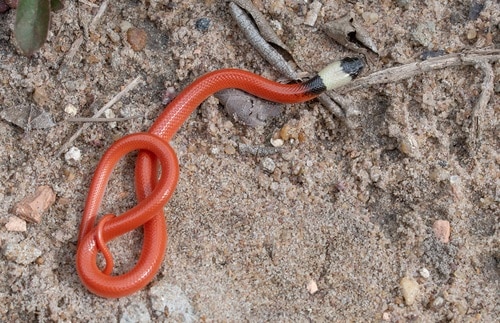
There are vast legions of snakes worldwide which have never been observed to play dead and probably never do. It seems especially rare in vipers, non-existent in rattlesnakes for instance, but there are still additions being made to the play dead club. There’s thousands of snakes worldwide, and so many are barely researched.
One mysterious snake is Neuwied’s false boa (Pseudoboa neuweidii), recognisable by its pure red body contrasting against a snowy white neck and black head. This species measures up to 100cm and is surprisingly venomous, with proteolytic toxins that almost match a Bothrops lancehead.
The first observation of it playing dead were made in Tocumen, in the Panamá district of Panama, in March 2019. Firstly, the cornered Pseudoboa neuwiedii flipped onto its back, then became fully immobile and rigid. It was placed into a plastic container, still with no response.
A few minutes later, the snake suddenly reactivated and attempted to escape the container. An hour later, the team moved to release the snake, and witnessed a repeat of the same death-faking cycle, proving that it wasn’t a fluke. Another disturbing characteristic of this snake is a face so black you can barely make out its eyes.
